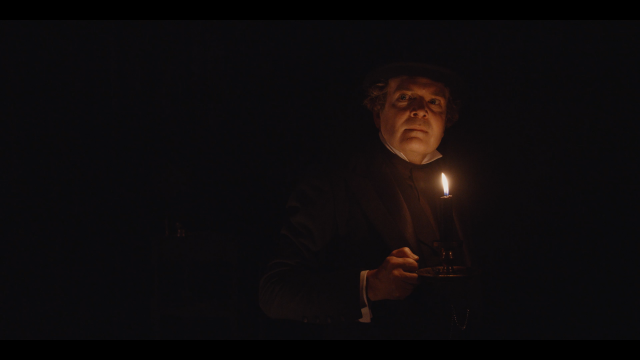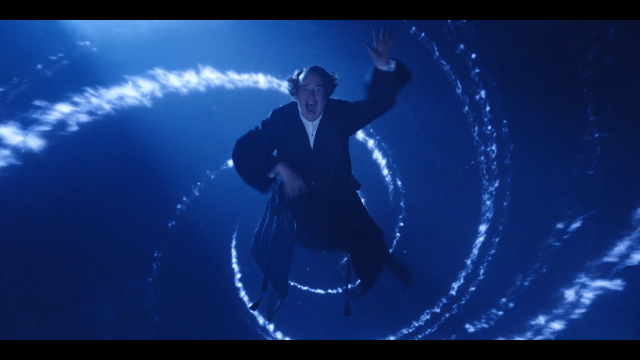
Jefferson Mays portrays more than fifty characters in A Christmas Carol (photo by Chris Whitaker)
A CHRISTMAS CAROL
Twenty-four-hour stream through January 3, $50 ($30 with code SCROOGE through 12/12)
Daily lottery: $15 (10 random winners)
www.achristmascarollive.com
Jefferson Mays’s mostly one-man version of Charles Dickens’s A Christmas Carol is the best filmed theatrical production made during the pandemic that I have seen. It is also the best one I’ve heard. Tony winner Mays may be the star of the holiday tale, spectacularly portraying more than fifty characters in ninety minutes, but Joshua D. Reid nearly steals the show with his stunning sound design, which works hand in hand with Ben Stanton’s pinpoint-precision lighting; headphones and as large a screen as possible are a must to fully appreciate this outstanding presentation. A big monitor and great speakers will also increase the scare level, because first and foremost, this telling is a ghost story, with genuine frights, one of which made my heart drop into my stomach.
Originally produced at the Geffen Playhouse in LA in 2018, the play, adapted by Mays and his wife, Susan Lyon, with director Michael Arden, has been reimagined by Arden and set and costume designer Dane Laffrey for online viewing. It was recorded in October at the historic United Palace theater on Broadway at 175th St., built in 1930 as a lush vaudeville and movie house that served as a church for the Rev. Ike and his ministry from 1969 to 2017. United Palace calls itself the Home of Spiritual Artistry, and that’s exactly what you’ll find in A Christmas Carol.
“Oh! But he was a tight-fisted hand at the grindstone, was Scrooge!” Mays announces early as the narrator. “A squeezing, wrenching, grasping, scraping, clutching, covetous, old sinner! Secret, and self-contained, and solitary as an oyster.” The word “solitary” hits us differently during the pandemic lockdown, as we watch a single actor onstage, performing in an empty theater for an audience of one, or maybe a few more, sheltering at home.
He continues, “Nobody ever stopped him in the street to say, `My dear Scrooge, how are you?’ No beggars implored him to bestow a trifle, no children asked him what it was o’clock, no man or woman ever once in all his life inquired the way to such and such a place, of Scrooge. Even blind men’s dogs, when they saw him coming on, would tug their owners into doorways. . . . But what did Scrooge care! It was the very thing he liked. To edge his way along the crowded paths of life, warning all human sympathy to keep its distance.” At that instant, Arden cuts to a far shot of Mays, looking lonely and far away, socially distanced from the rest of humanity.

A Christmas Carol has been reimagined for online viewing during the pandemic (photo by Chris Whitaker)
Cinematographer Maceo Bishop’s camera follows Mays across the space, zooms in for extreme close-ups, and occasionally pulls back to remind us that Mays is on a stage; this Christmas Carol is a hybrid piece of film/theater, a new kind of work that is both and neither, something that is likely to last beyond Covid-19, when venues are open again for audiences to sit together in community while people around the world are craving access to the same show. At one point, when Mays is shifting between Ebenezer Scrooge and one of the ghosts, Mays not only changes his voice for each character, enhanced by Reid’s bold sound manipulation, but he merely needs to shift his shoulders from left to right to move between the roles, his face bathed in green as the ghost and in white light as the grinchy banker. It’s a terrifying scene that could not be captured in the theater for all to see, while on a movie screen it would lose its intimacy. There are also video projections, smoke and fog, and lighting effects so palpable they have an intense physicality to them.
Mays knows his way around multiple parts; his breakthrough came in 2003 in Doug Wright’s Pulitzer Prize-winning I Am My Own Wife, in which he portrayed the real-life Charlotte von Mahlsdorf and thirty-nine others, earning a Tony, and he played nine members of the D’Ysquith family in the Tony-winning musical A Gentleman’s Guide to Love and Murder. In A Christmas Carol, he plays more than fifty characters, from Jacob Marley, Bob Cratchit, Fezziwig, and Tiny Tim to Fred, Scrooge, and the Ghosts of Christmas Past, Present, and Future. He does so in the same Victorian outfit, a white shirt under a dark suit and long coat, with a top hat. His hair, styled by Cookie Jordan, fluffs up over each ear, evoking an unbalanced Princess Leia.
Mays inhabits the roles from the very start with an easygoing grace and familiarity; when he was a child, his parents would read the story to the family every year. Two-time Tony nominee Arden (Spring Awakening, Once on This Island) began his career playing Tiny Tim in a Texas community theater production of A Christmas Carol when he was ten. The care and understanding they have for the material shines through; the only weakness is Sufjan Stevens’s treacly caroling, which feels like it was meant for a different holiday show.
A Christmas Carol streams through January 3 and is a benefit for more than fifty local theater companies and venues around the country that have been impacted by the Covid-19 crisis. When two gentlemen knock at the door seeking a charity donation, Scrooge is none too happy, leading to the following exchange:
“Many thousands are in want of common necessaries; hundreds of thousands are in want of common comforts, sir.”
“Are there no prisons?” asked Scrooge.
“Plenty of prisons,” said the gentleman.
“And the Union workhouses?” demanded Scrooge. “Are they still in operation?”
“They are. Still,” returned the gentleman, “I wish I could say they were not.”
He politely gets to the point.
“What shall I put you down for?”
“Nothing!” Scrooge replied.
“You wish to be anonymous?”
“I wish to be left alone,” said Scrooge. “Since you ask me what I wish, gentlemen, that is my answer. I don’t make merry myself at Christmas and I can’t afford to make idle people merry.”
This Christmas Carol should make many people merry during what will be a very challenging holiday season, with the coronavirus raging inside and outside prisons, millions out of work, so many charities and businesses in need of funds, and the desperate need to not be alone overwhelming our daily existence. Mays, Arden, et al. don’t just transport us to another plane for ninety thrilling minutes — they have given us a present that will stay with us for a long time.